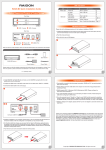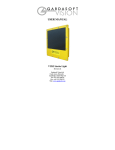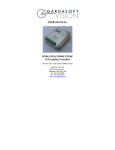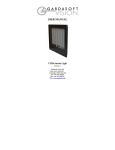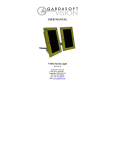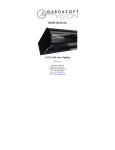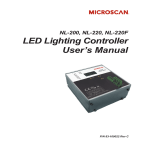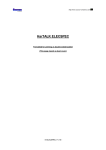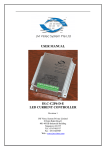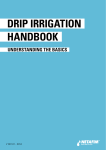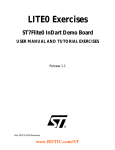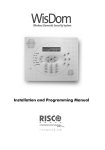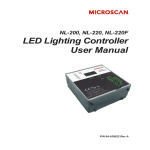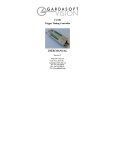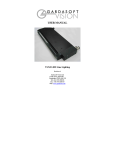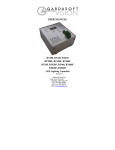Download USER MANUAL - Stemmer Imaging
Transcript
USER MANUAL PP420, PP420F LED Lighting Controllers Revision 06 Gardasoft Vision Ltd Trinity Court, Swavesey Cambridge, CB24 4UQ. UK Tel: +44 1954 234970 Fax: +44 1954 231567 Web: www.gardasoft.com 1 Disclaimer Except as prohibited by law: All hardware, software and documentation is provided on an “as is” basis. It is essential that the user ensures that the operation of the product is suitable for their application. The user must ensure that incorrect functioning of this equipment cannot cause any dangerous situation or significant financial loss to occur. Gardasoft Vision Ltd and Gardasoft Products Ltd will not accept any liability for consequential loss of any kind. All trademarks acknowledged. Hardware, software and documentation are Copyright 2002 – 2010 Gardasoft Products Ltd. Hardware manufactured by Gardasoft Vision Ltd under licence. 2 Getting Started Read the sections on Safety and Specifications and check the PP420 fulfils your requirements. See the back cover for other Gardasoft Vision lighting controllers. Connect the PP420 up to a power supply, Ethernet network and lights as described in Connections. Mount the PP420 as described in “Mechanical Fixing” using a DIN rail or the mounting holes. Read the section on Heat Dissipation. Set up the PP420 for the desired operation and test. Download, install and run the PP420 Configuration Program from www.gardasoft.com. If you need to use a fixed IP address set this up using the Configuration Program. Search for the PP420 on the network and then connect to it. On the Configuration tab, set up the current rating of the lighting and the mode of operation of each light. Visit www.gardasoft.com for Application Notes. There is also a Support page which has information on troubleshooting problems. Throughout this manual, references to the PP420 refer to all variants in the PP420 range unless otherwise stated. The symbol “us” is used to denote microseconds. 3 3.1.1 Safety - English PP420 – Safety Please read this before using the PP420 family of products. If in doubt, contact your distributor or Gardasoft Vision. Where this symbol appears in the manual, refer to the text for precautions to be taken. 3.1.2 Heat The PP420 can get very hot. It should be positioned where personnel cannot accidentally touch it and away from flammable materials. Read the section on Heat Dissipation. Do not exceed the power ratings given in the manual. Note that at the maximum ratings the case temperature can reach 80oC. 3.1.3 Electrical The user must ensure that the potential difference between any combination of applied signals does not exceed the supply voltage. WARNING: Higher voltages may cause a danger to personal health. The PP420 does not have complete tracking isolation of inputs and outputs. Transients caused by inductive loads must be suppressed external to the PP420. 3.1.4 General The PP420 must not be used in an application where its failure could cause a danger to personal health or damage to other equipment. If the equipment is used in a manner not specified by the manufacturer, the protection provided by the equipment may be impaired. 4 General Description The PP420 current controller provides repeatable intensity control of LED lighting for machine vision applications. It includes the power supply, intensity control, timing and triggering functions required for machine vision systems. LED lighting needs a constant current supply as small variations in voltage can cause large variations in light output. Currents can be specified in 2.5mA steps to give very fine control of intensity. Three modes of operation are provided separately for each channel: Continuous In continuous mode the output is a continuous current. Pulse (Strobe) In this mode output is pulsed once per trigger. One trigger input is used as a trigger. The delay and pulse duration can range from 20us to 1 second in 20us. Switched In switched mode a trigger input can be used to switch the output current on and off. The output is only enabled when the input has a voltage on it. Configurations are saved in non-volatile memory so that the PP420 will resume operation after a power cycle. The PP420 is set up using the push buttons and display on the front of the unit or using Ethernet commands. The set up is non-volatile, so the PP420 will resume the same operation after a power cycle. 4.1 Default Configuration When shipped the PP420 has the following configuration: Ethernet set to DHCP mode Each channel set to 0.1A rating, no autosense, continuous output at 50% 4.2 Automatic Light Sensing When a channel does not have a light connected, the PP420 continually tries to put out a very small current. Each channel operates independently. When a light is connected, it will flash for a short time (the light will not be damaged by this) until the PP420 detects that it is connected. If the AUTO_SENSE flag is set or a current rating has not been entered for this channel then the PP420 will wait for the current rating to be set. This flag can be set using the Configuration Program, Channel Configuration webpage or using the RR command from an application program. If Ethernet messages are enabled, when a light is connected and the user is being prompted to enter the current rating, the PP420 will send one of these two messages: Evt c,129 A light has been detected and the current rating needs to be input Evt c,128 A light has been detected and the current rating is not needed Where “c” is the output channel number. An application can send an RR command back in reply, which will cancel the user prompt. Once the PP420 has detected the light and has a current rating for it, the light will start its configured operating mode. The RE Ethernet command can be used to enable/disable the current rating request. The PP420 will then use the previously entered current rating. If the PP420 is turned off and on again, without an error occurring, then the PP420 will autosense the light and assume it is the same light and so will not prompt for the current rating again. Once an error has occurred, the user will be prompted next time a light is detected. When a light has not been detected the following reasons can be displayed on the webpage: Error Reason Reset No connect – (reason) Light not detected Detecting Light is currently being detected. Waiting for current rating The current rating needs to be entered. The light has been detected, but the AUTO_SENSE flag is set and the controller is waiting for the current rating to be entered. Connected Light operating normally Error – nn The light was operating but has been turned off due to an error (see appendix C) The user must press SEL to cancel the error (or send command “GR” using the Ethernet connection) and the PP420 will then re-sense the light and ask for confirmation of the current rating. 4.3 Output Modes There are four trigger inputs. The sense of these signals can be active high or active low, as set by the “P” flag. The trigger inputs are used as follows: Mode Trigger Input Output Continuous Don’t care Output is on. Switched Trigger = 0V Output is off Trigger = 4.5V to 24V Output is on Trigger goes from 0V to 4.5V Pulse is triggered Trigger goes from 4.5V to 0V No action Pulsed 4.3.1 Continuous Output and Switched Output In continuous mode the output current is fixed and continuous. Switched mode uses a trigger input to switch the output on or off. In continuous and switched modes, the output current can be varied from 0% to 100% of full brightness. 4.3.2 Pulsed Output The output is off by default. When a trigger is the PP420 will wait for a delay and then pulse the output. The delay, pulse width and pulse intensity are all configurable. If the “P” flag is set triggers occur on the leading edge of the input, that is on the transition from 0V to (for example) 5V. In pulsed mode, the brightness can be set up to 999% of its rating, but only for short periods and at low duty cycles, so that the lighting does not overheat and get damaged. The default limits are as follows. Other limits are available. Output Brightness Allowed Pulse Width PP420, PP420 Allowed Pulse Width PP420F, PP420F Allowed Duty Cycle 0 to 100% 999ms 10ms 100% 101% to 200% 30ms 1ms 30% 201% to 300% 10ms 1ms 20% 301% to 500% 2ms 1ms 10% 501% to 999% 1ms 0.5ms 5% So for example, if the brightness is set to 350%, then the PP420 will not allow pulses greater than 2ms long. If the trigger pulses are too close together so that the lights are on for more than 10% of the time, the PP420 will stop the output and flag an error. 4.3.3 Current Protection The PP420 monitors the output current and voltage and ensures it is within acceptable limits. The RE Ethernet command can be used to disable error checking. This is not absolute protection but does provide some safety when setting up the PP420. 4.3.4 Channel Flags Each channel has some configuration flags. S Flag enables or disables autosensing. When this flag is set, the PP420 will autosense - when a light is connected for the first time, the PP420 will wait for the current rating to be entered (using the webpage, Config program or UDP message) before continuing. When this flag is not set, the PP420 will use the previously set current rating. E flag enables or disables error checking. When this flag is not set, the PP420 will not detect lighting errors. P flag inverts the trigger signal. In pulse mode, when set the PP420 triggers from the rising edge of the trigger. When not set, the PP420 triggers from the falling edge. The falling edge may give a slower response time. In Switch mode, when the flag is set, the output is on when the input is on. Clearing the P flag inverts this operation. 5 Parameter Specifications Value Notes Digital supply voltage (PSU+) 12V DC to 48V DC regulated Must be at least 1V greater than the load potential difference at maximum required current Supply current with no lights connected 120mA This is with a 12V supply. The current is lower at 24V. Input enable level From 3V to 24V Input disable level <1 V Typical trigger input current required 3mA at 3V to 24V Maximum output current per channel 2A continuous or 10A pulsed Ambient temperature during operation 5oc to 50oc The ambient temperature may need to be lower if the PP420 is dissipating a lot of heat Total allowed power dissipation without heatsinking (PD) PD=8 Watts (max) See Section 7 for information on heat dissipation This is the voltage applied between the positive and negative of each trigger input 6 Mechanical Fixing The PP420 can be mounted onto a flat surface using the mounting holes in the corners, see diagram. The PP420 should only be mounted either vertically or with its base horizontal. It should be mounted at least 15mm away from the sides of plastic enclosures. Likewise leave a similar space between the PP420 and any parts which could be affected by high temperatures. The enclosure of the PP420 is used to dissipate power in the form of heat. See the section on Heat Dissipation. The PP420 can be mounted from above using the corner holes, or from beneath using the M4 tapped holes (maximum screw length inside is 6mm). The PP701 kit is available for mounting the PP420 on a DIN rail. To avoid a fire hazard consider the implications of overheating in the unlikely event of a fault in the PP420. The power dissipation in a fault condition is approximately given by the sum of the following for the four channels: (<Power supply voltage> - <rated voltage for lighting>) * <max current delivered by Power supply> Either limit the power supply output current(s) so that not more than 30W can be dissipated in the PP420, or mount the unit in an enclosure. To limit the power, set the power supply output voltages to the minimum value required by the LED light and the PP420 together. Chose a PSU that limits its output current by design, by setting the current limit on the supply (if this feature exists) or use fuses. Remember to derate the fuse, if mounted in an enclosure, as the temperature will be higher than ambient. The PP420 enclosure is a fire enclosure as long as the following conditions are met: • The Ethernet connector must not be facing downwards • The mounting holes on the underside must be covered or have a screw fitted. If an enclosure is used, the enclosure should be metal or plastic (with a flammability rating of UL94 V1 or better); with no holes below or to the sides of the PP420 when mounted. Cable entries below the PP420 should be via glands that have a flammability rating as before. Observe the specified gap between the PP420 and any other part or side of the enclosure. The PP420 does not have an IP rating and should be mounted so that moisture and dirt cannot enter the unit. 7 Heat Dissipation The PP420 has a linear circuit to produce the constant current output. This means that it generates heat which needs to be dissipated. See application note APP926 for more information on heat dissipation and a spreadsheet There is a spreadsheet available (APP939) which gives an easy way to work out the heat dissipation of the PP420. 7.1.1 Heat Output Per Channel For a continuous output current the heat output is given by: <heat output (W)> = <output current (A)> * ( <supply voltage (V)> - <voltage across lighting (V)> ) where: Output current Set by the user Supply voltage Voltage across PSU+ and PSU- Voltage across lighting Voltage across LD1+ and LD1- (for channel 1) This is usually easy to calculate as the voltage across the lighting is usually the voltage rating of the light given in its specification or can be measured using a voltmeter. For a pulsed output the heat output is given by: <heat output (W)> = <output current (A)> * <duty cycle> * ( <supply voltage (V)> - <voltage across lighting when pulsing (V)> ) <duty cycle> = <pulse width in seconds> * <trigger frequency in Hertz> When overdriving, the voltage across the lighting is more difficult to find out. In most cases it is reasonable to use the voltage rating of the light. 7.1.2 Total Heat Output The heat output for the PP420 is given by adding the heat output for both channels, as calculated above. There are several ways to reduce the heat output from the PP420: • Use pulse mode. If the output is only on when you need it then you can dramatically reduce the heat output. Feed the camera trigger into the PP420 and pulse the lights. • Turn the light off when not needed. If you don't have precise timing of when the camera will trigger, you can use Switched mode to switch the output off or on depending on the trigger input (or use the PP420 and use Ethernet commands to turn the output on and off). • Reduce the output current if possible • Reduce the supply voltage. Most PSUs have some adjustment in their output voltage. • Connect lights in series instead of parallel. If you have an array of lights or LEDs in parallel then changing the arrangement to serial will increase the voltage across them but reduce the overall current. • Use two PP420s and use one channel from each. For high power applications this may be the easiest solution. Even with one light, it is possible to parallel up two output channels from different PP420s. • Use a PP820. These controllers can dissipate much more heat. With no heatsinking and no airflow, the PP420 can dissipate approximately the following: 8W at 30OC ambient 6W at 40OC ambient 4W at 50OC ambient If the heat output is no greater than these limits, then no heatsinking is required. If the heat output is above but less than 24W then the PP420 needs to be bolted to a solid piece of metal to dissipate the heat. Above 24W, it is necessary to have a large heatsink with fan cooling. LED1LED1+ POWER/LOAD LED2+ LED2- PSU- Power Supply – ve (GND) LED4+ LED4TRIG A - see illustration to right Operating Conditions Channel 2 output to lighting Power Supply +ve LED3+ TRIG1- Channel 3 output to lighting Channel 4 output to lighting Trigger input 1 TRIG1+ TRIG2TRIG2+ TRIG3- Trigger input 2 Trigger input 3 TRIG3+ TRIG4TRIG4+ Opto-Coupled Trigger Input Details Channel 1 output to lighting PSU+ LED3- TRIG B - see illustration to right Connections Function Screw Terminal ID Connector 8 Trigger input 4 3V ∗ VTRIG ∗ 24V Logic 1 VTRIG ∗ 1V Logic 0 VF 1.5V typ Ensure that the wire gauge used for these connections is appropriate for the current to be drawn. Ideally, wires should be double crimped or independently secured to ensure they cannot come loose. Route low voltage and mains wiring separately. If they must be loomed together ensure that low voltage insulation rating is sufficient or that supplementary insulation is used. The PP420 has a single power input connection (which is different from the PP600). Power supplies should be regulated with SELV compliant outputs (fault tolerant). Consideration should be given to fusing PSU+. The fuse value can be based on the average current output. Note that in Europe fuses are designed to conduct at their rated current, while in the USA fuses are designed to blow at their rated current. The RJ45 Ethernet connector requires a straight through cable to connect into a network switch, hub or router. It runs at 10Mbits per second. 9 Ethernet Setup You may need to ask your network administrator for advice about setting up the Ethernet connection. Ethernet set up is not affected by cold booting the PP420. 9.1 Connection The Ethernet link uses a 10 base-T connection on an RJ45 connector. The PP420 will usually be connected to a network switch (or hub or router). It is also possible to connect it direct into the network port on a PC by using a swapover cable. 9.2 MAC Address The PP420 MAC address is: 0x00.0x0B.0x75.0x01.0xNN.0xNN. 9.3 IP Address The PP420 needs an IP address to communicate over Ethernet. There are two ways to get an IP address; either programmed into the unit or using DHCP. Most networks use a DHCP server. If there is a PC on the network, You may be able to find out whether a PC on the same network uses DCHP as follows: • Go to Control Panel • Select Network Connections • Right click on Local Area Connection. Select Properties • From the list, select Internet Protocol (TCP/IP), press Properties If “Obtain an IP address automatically” is set, then DHCP is probably used. However, there may be an alternative fixed IP address on the “Alternative Configuration” tab. You can find out what IP address is being used by a PC at any time by: • Go to Control Panel • Select Network Connections • Right click on Local Area Connection. Select Status • Select the Support tab. The IP address is displayed When using a fixed IP address, you must ensure that you use an IP address that is not being used by any other device on the network. It is usual to keep the first three numbers of the IP address the same as other devices and to change only the last number. For example, if you have a network consisting of a PC (IP address 192.168.1.35) and two PP420s, you might give them addresses 192.168.1.201 and 192.168.1.202. 9.3.1 Programmed IP Address and DHCP For DHCP mode, the PP420 acquires its IP address, subnet mask and gateway address from a DHCP server. Otherwise the PP420 has a fixed IP address, subnet mask and gateway address. DHCP mode or a fixed IP Address can be set up using the PP420 Configuration Program. This will work on any network, as the Configuration Program broadcasts the network setup message to the PP420. The message includes the serial number to ensure that other Gardasoft products ignore the message. The default configuration is DHCP mode. The IP address can also be detected using the Configuration Program. The Configuration Program is available for download at www.gardasoft.com. 10 Communication All the features below are implemented in a Configuration Program available from www.gardasoft.com. 10.1.1 Automatic Sensing The PP420 will send out a message on three events: • On power up • When an IP address is received or renewed by DHCP • When an enquiry message is received On the first two events, the message is broadcast. On the third it is a reply to a single IP address. An enquiry message is a UDP packet from source port 30310, destination port 30311 with the message body “Gardasoft Search” (8-bit ASCII, 13 characters). The message output by the PP420 is a UDP packet from source port 30311, destination port 30310. It is formatted as: Gardasoft,PP420,000000,111111111111,22222222 (8-bit ASCII, 44 characters), where 000000 the serial number of the unit 111111111111 the MAC address in 6 HEX bytes 22222222 the IP address in 4 HEX bytes For example for PP420 serial number 12345, IP address 192.168.1.103, MAC address 00.0B.75.01.80.99 the packet will contain Gardasoft,PP420,012345,000B75018099,C0A80167 11 Webpage Configuration The PP420 has a small webserver inside, so that it can be configured from a standard web browser, such as Internet Explorer. The IP address of the PP420 must be known (see the section on “Ethernet Setup.” Open a web browser window and type the IP address (for example 192.168.1.71) of the PP420 into the URL box at the top. The main page of the PP420 webserver should be shown. The configuration pages can be protected using a password. 11.1 Index Page The index page shows general information about the PP420. Links are provided to the configuration pages. 11.2 General Configuration Page The General Configuration page allows the webpage protection password to be set or cleared and the internal trigger to be set up. Also any Ethernet command from Section 12 can be entered. “Test Mode” referred to on this page is the internal trigger timer. 11.3 Channel Configuration Pages There is one Channel Configuration Page for each output channel. All the parameters for each output channel can be set up. Press the Submit button to update the PP420 and save the changes to non-volatile memory. 12 12.1 Ethernet Configuration Communication The PP420 can be configured via the Ethernet connection using UDP or TCP/IP. A Configuration Program with source code can be downloaded from www.gardasoft.com. Communication consists of commands sent by the host (controlling PC). All output generated by the command is returned in reply UDP or TCP/IP packets. The last character sent is “>” (“greater than” symbol). Once this is received, the host knows that the command has been completed. It is recommended that the host waits for the “>” symbol before sending the next command. UDP communications are not guaranteed to arrive, so the host software must be able to cope with lost messages. Using the GT command, a host can request that a message is sent to it whenever an error occurs. For TCP and UDP, commands from a host should be sent to destination port 30313. Replies will be to destination port 30312. A TCP/IP connection will timeout and close if it is idle for more than 10 seconds. The host must send regular “heartbeat” commands (eg “VR”) to keep the link open. 12.2 Configuration Program A Configuration Program is available from www.gardasoft.com which allows the PP420 to be configured using the commands below. 12.3 Command Structure Several commands can be put into one command line by separating them by a semi-colon (“;”). A carriage return character should be sent to terminate the command line. The PP420 will send any replies to the commands and then send a ‘>’ character to indicate that the command line has been completed. Commands comprise a code of two letters followed by the parameters (if any) needed for the command. Spaces in the commands are ignored. Numeric parameters are separated by a comma (“,”). For a parameter which is a time period the default units are milliseconds. “s”, “ms” or “us” can be added to the end of the number to indicate seconds, milliseconds or microseconds. For currents, “a” or “ma” can be added to indicate “amps” or milliamps”. The default is amps. For example: Parameter Meaning 0.1 0.1 milliseconds 200us 200 microseconds 0.1s 0.1 seconds 100ma 100mA 2.45A 2.45A 2.3 2300mA or 2.3A Note that parameters are in “USA/UK” format so that a half is written “0.5” not “0,5” The command codes and their meaning are described below. The upper case commands are shown, followed by lower case letters denoting the numeric argument. Error number Reason Err 1 A parameter value is invalid Err 2 Command not recognised Err 3 Numeric value is wrong format Err 4 Wrong number of parameters Err 5 (Warning only) A timing parameter was out of range and has been adjusted. Any changes made using Ethernet commands are not saved permanently until the AW command has been issued. 12.3.1 General Commands Save the settings to memory. AW Once the settings are saved to memory they are then retained when the unit is switched off. If this is not done, changes to the settings are volatile, and if the unit is switched off they revert to those in force when the last AW command was issued. Report the configuration ST Typical output is: CH 1, MD 2, IP 4, CS 0.100A, SE 75.0, DL 2.0us, PU 300.0us, RT 500.0us, FL 1 CH 2, MD 0, IP 2, CS 0.100A, SE 25.8, DL 1.000ms, PU 1.000ms, RT 0.0us, FL 0 CH 3, MD 0, IP 1, CS 0.100A, SE 50.0, DL 1.000ms, PU 1.000ms, RT 6.000ms, FL 4 CH 4, MD 1, IP 4, CS 0.100A, SE 100.0, DL 100.0us, PU 1.000ms, RT 0.0us, FL 5 Where the numeric values are: CH Channel number MD Mode: 0 = continuous, 1 = pulse, 2 = switched IP Trigger input: 1, 2, 3, 4 CS Current rating of the light SE Brightness percentage setting DL Pulse delay PU Pulse width RT Retrigger delay ST0 Reports the general settings. Typical output is: TM 1, TP 20.00ms STc Where c channel number (1 or 2) Reports settings for a single channel. Enable Ethernet Messages GTm m = 0 to disable Ethernet messages = 1 to enable Ethernet messages When Ethernet messages are enabled, any error reports are sent to the most recent UDP or TCP address from which a command has been received. Messages are of the form: Evtc,e Where c zero for no channel or channel number (1 or 2) v event value: 32 to 47 Lighting error code 128 Light detected and waiting for current rating 129 Light detected and not waiting for current rating Clear any Errors GR If Ethernet messages are not enabled, the last event or error number can be read by this command. Any error displayed on the unit is cleared, so if there was a lighting error, the PP420 will resume auto-sensing on that channel. The reply will be in he same form as the GT command above. If ther are no outstanding events or errors, then only the prompt “>” is returned. Report the version of firmware running in the PP420 VR This command returns the firmware version. For example: PP420 (HW001) V002 Clear Settings CL Clears the output channel configuration. This excludes the Ethernet settings. For each channel, if the AUTO_SENSE flag is set, then the flag and the current rating are preserved. Set/Clear the Webpage Password EY EY asc1, asc2, asc3, asc4, asc5, asc6 This command sets the password required to access the webpages. If EY is entered on its own then the password is cleared. There are six optional parameters, which are ASCII values for a password from one to six letters. A value of 65 is ‘A’, 66 is ‘B’, etc to 90 is ‘Z’. Set the Channel Flags REc,m Where: c = output channel (1, 2, 3, 4) m = Flags, where bit 0 1 = No autosense (current rating is fixed) 0 = Autosense (current rating needs to be entered on connection) bit 1 1 = No error detect 0 = Error detect. The PP420 continually monitors the output current and voltage bit 2 1 = Negative trigger. In pulse mode the trigger is the falling edge. In switched mode a low input turns the light on. 0 = Positive trigger. In pulse mode the trigger is the leading edge. In switched mode a high input turns the light on. Set the trigger input This command changes which input is used when in switched or pulsed modes. RPc,t Where: c = output channel (1, 2, 3, 4) t = trigger input (1, 2, 3, 4) Set the output current rating This command changes the current rating for a light. RRc,v Where: c = output channel (1, 2, 3, 4) v = rated current (10mA to 2A) Set continuous mode The output is set to continuous mode at a percentage of full brightness. RSc,s Where: c = output channel (1, 2, 3, 4) s = setting in percent (s = 0 to 100) Set switched mode The output is set to switched mode at a percentage of full brightness. RWc,s Where: c = output channel (1, 2, 3, 4) s = setting in percent (s = 0 to 100) Set pulse mode The output can be set up to pulse on a trigger input. The delay from trigger to the start of the pulse, the length of the pulse and the brightness are configurable. An error is generated if the brightness setting requires a current greater than 10A or if the combination of pulse width and setting is not allowed. RTc,p,d,s RTc,p,d,s,r Where: c = output channel (1, 2, 3, 4) p = pulse width in milliseconds (0.02 to 999) d = delay from trigger to pulse in milliseconds (0.02 to 999) s = setting in percent (s = 0 to 999) r = retrigger delay. This parameter is optional Simulate an Input Trigger TRc c which input channel (1, 2, 3, 4) Simulates a trigger pulse. If the channel is in pulse mode it will pulse and show “PUL” on the display. Set Internal Trigger Enable or disable the internal trigger. When enabled, all outputs are triggered simultaneously using an internal trigger signal. This setting can be saved to non-volatile memory using the AW command. TT0 Disable internal trigger TT1 Enable internal trigger (uses previously set period) TT1,p Enable internal trigger and set the period Where: p= period of the triggers in microseconds For example: TT1,200 TT1,500US 12.3.2 Set the internal trigger to 200ms (5Hz) Set the internal trigger to 500us (2KHz) Command Summary Command Example Effect AW AW Save changes ST ST Show configuration GT GT1 Enable Ethernet messages GR GR Get any error codes VR VR Red the firmware version RR RR1,0.2 Set the rating of channel 1 to 0.2A RS RS2,65 Set channel 2 to 65% brightness continuous RW RW1,50 Set channel 1 to 50%, switched by Trig 1 RT RT2,3,4,50 Set channel 2 to 3ms pulses, delayed by 4ms, at 50% brightness TT TT1,1ms Set internal triggers every 1ms TR TR2 Simulate trigger on trigger input 2 CL CL Clear all settings, except Ethernet EY EY80,87 Set webpage password to “PW” RP RP2,3 Use trigger input 3 for Channel 2 RE RE1,3 Set channel 1 to ignore lighting errors and not prompt for the current rating of a light when it is connected. A. Timing The following timings apply for firmware revision V014. A.1 Switched Mode The maximum delay from a trigger input changing to the output current being turned on or off is 10us. A.2 Pulse Mode For the PP420F the minimum pulse delay is about 4us. B. Firmware Upgrade On the PP420 and PP420F the firmware can be upgraded using the Ethernet interface. Contact your distributor for more information. C. Error Codes If Ethernet message are enabled, these errors cause a message to be sent of the form: Err c,e Where: c = output channel (1, 2, 3, 4) e = error number Error number Reason Err 1 A parameter value is invalid Err 2 Command not recognised Err 3 Numeric value is wrong format Err 4 Wrong number of parameters Err 5 One of the parameters is out of range. The value of the parameter has been adjusted. For example, sending an RT command with a delay of 0 will get a reply of “Err 5”. When the settings are viewed the delay will have been set to 20us (PP420) or 4us (PP420F). Err 8, 12 EEPROM corrupt. The configuration has been cleared. Err 20 Couldn’t save settings to EEPROM. Err 27 Can’t read Ethernet settings from EEPROM, so these may be incorrect. Err 34 Internal power dissipation is too high. Output turned off Err 35 Output current to lighting is too low. Err 39 There is not enough supply voltage for the requested output current. Err 36 The output is short circuit. Err 42 The output current is too high. Err 37 The voltage required for the lighting has increased too much. Check for ageing of the lighting or a failed LED. Err 38 The voltage required for the lighting has decreased too much. Check for ageing of the lighting or a failed LED. Err 44 Temperature error. The PP420 is too hot and has switched off to protect itself. Err 40, 41, 45 More current is being output than should be, so the PP420 has turned off the outputs. This may be caused by a hardware error. Check with your distributor. Any other errors are internal errors. Gardasoft LED Lighting Controllers The products available at the time of writing include the following. Other products are also available. See www.gardasoft.com for details of the current range. RT Range • • • • • 2, 4 or 8 output channels up to 20A each 2, 4 or 8 trigger inputs SafePowerTM and SafeSenseTM Front panel, RS232 or Ethernet configuration Fast pulsing option RT200-20 RT220-20 RT260-20 RT200F-20 RT220F-20 RT260F-20 RT420-20 RT420F-20 RT820F-20 RT860F-20 PP704 Lighting controller: 2 channels up to 20A pulsing, front panel Lighting controller: 2 channels up to 20A pulsing, Ethernet Lighting controller: 2 channels up to 20A pulsing, RS232 Lighting controller: 2 channels up to 20A fast pulsing, front panel Lighting controller: 2 channels up to 20A fast pulsing, Ethernet Lighting controller: 2 channels up to 20A fast pulsing, RS232 Lighting controller: 4 channels up to 20A pulsing, Ethernet Lighting controller: 4 channels up to 20A fast pulsing, Ethernet Lighting controller: 8 channels up to 20A fast pulsing, Ethernet Lighting controller: 8 channels up to 20A fast pulsing, RS232 DIN Rail mounting clip for RT range PP Range • • • • • 2, 4 or 8 output channels up to 20A each 2, 4 or 8 trigger inputs SafeSenseTM option Front panel, RS232 or Ethernet configuration Fast pulsing option The PP range will continue to be available for many years. Machine Vision Timing Controller CC320 Controller • • • • • • 8 digital inputs 8 digital outputs 1 or 2 wire Encoder input Very flexible operation Ethernet control Front panel configuration PP703 DIN Rail mounting clip for CC320


























